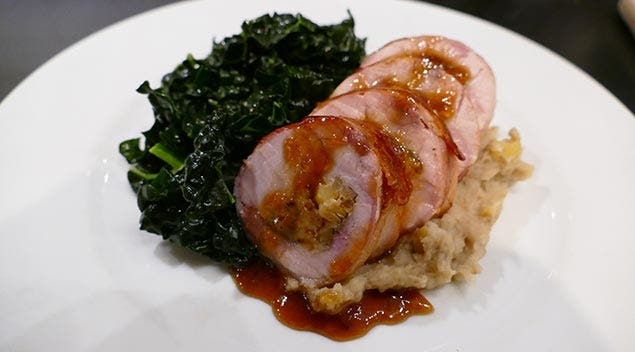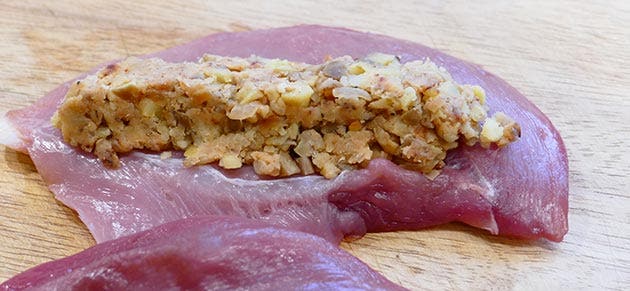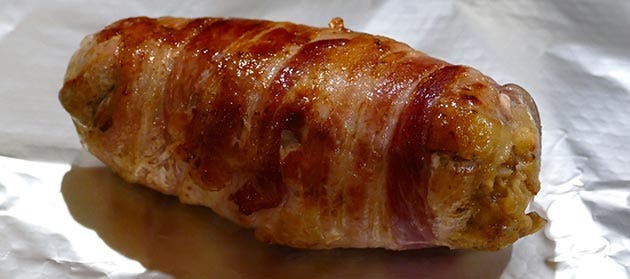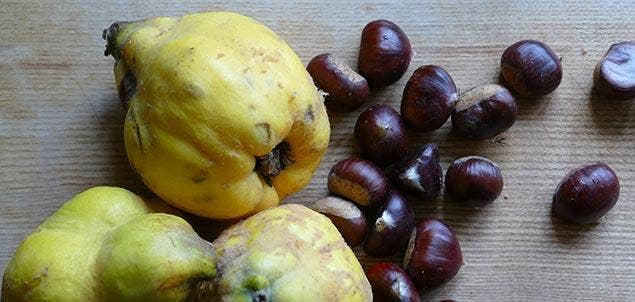So far this has been a year of meteorological extremes. For the first few months we were battered by Siberian temperatures, high winds and incessant rain. Then, all a sudden, we faced cracked earth and hosepipe bans during the hottest summer since 1976. I’m sure the shift from deluge to drought wasn’t quite overnight but the transformation was quick enough to make it feel as though our usual seasonal progression was unnervingly off kilter.
How satisfying then has been the coming of autumn, bringing with it some reassuringly ‘normal’ weather and, of course, the start of the shooting season. I can’t predict what the changing climate is going to throw at us but I can at least help to suggest some interesting ways of using pheasants as they arrive in the kitchen.
Pheasant pie
The solution I always think when pheasant first appears in my kitchen is pie and this was a seasonal regular on our table when I was growing up; it was one of my mother’s signature dishes and the one that gave rise to my enduring love of gameShe always roasted the whole birds first, gaining the extra depth of flavour which comes from cooking meat on the bone and deglazing the roasting pan with red wine to enhance the sauce. The pheasant should then be allowed to cool completely before the meat is stripped off and enveloped in a roux-based sauce involving red wine and chicken stock. Bay and thyme are both excellent additions to the sauce, but do remember to remove them before you assemble the pie. Softened onions and plenty of chestnut mushrooms are finally combined with the pheasant meat (a mix of both breast and leg gives a more interesting mix of flavour and texture) and sauce before the whole thing is crowned with pastry - with game I much prefer the earthier and more textural shortcrust, but use shop bought puff if you prefer! It’s heaven in a pie dish and a recipe I’ll never get bored of.

One pot option
If it suits you better to have a one pot dish there are plenty of options. One of my favourites is a recipe I have used with chicken and duck as well as pheasant and it’s a brilliant way of allowing the legs of the bird to shine, and in this context they are superior to the breast.The basic idea is to slowly braise the legs on top of their bulky accompaniment. For this I usually use brown rice (white is fine but the nuttiness of brown is an asset here) to which I like to add a Spanish vibe. To achieve this, soften some sliced shallots in rapeseed oil with finely chopped celery and carrot, a grated clove of garlic and a generous pinch of salt. While that is cooking, season your pheasant pieces and brown them in oil, then leave them to the side while you get the rest of the dish ready.
Still over a very low heat, add some chunks, slices or matchsticks of chorizo to the onions and allow the paprika-spiked oil to render out into the vegetables. Add a sliced red pepper and soften, then when it is all beginning to look quite unctuous stir through the rice so it is all coated with the flavoured oil. Then you just need to add some chicken stock (double the volume of the rice). I also like to include some saffron threads, which you can soak in hot water for a few minutes first to maximise their impact - but don’t forget to throw in the water as well as the threads! At this point, sit the browned pheasant joints on top of it all, bring it to a very gentle boil, put a lid on and sit it in the oven for at least two and a half hours but up to four, or even beyond.
The great thing is that because there is a limited amount of liquid to be absorbed by the rice it can’t end up horribly soggy, despite the long cooking time. The meat will be falling off the bone and its juices add to the already wonderful flavours in the rice. If I’m using this for weekend entertaining, we’ll have a big green salad on the side.
In a similar vein, you could use pearl barley instead of rice, starting with the same combination of onion, carrot, celery and garlic but then adding cubes of pancetta or bacon, lots of sliced leeks and maybe some mushrooms. I love the texture of pearl barley and it provides the perfect backdrop to the tender, flavoursome pheasant.
Pheasant accompaniments
Another way of ringing the changes with pheasant is to give it an interesting variety of accompaniments and one of the many wonderful things about autumn is that it heralds the arrival of such a huge range of deeply flavoured ingredients, many of which go brilliantly with it.If you are a fan of pot roasting your pheasant, rather than serving it with the wonderful - but ubiquitous - mashed potato, try some alternatives. Celeriac is never going to win prizes for beauty but its distinctive flavour complements pheasant particularly well. Try my recently discovered celeriac and chestnut mash (see recipe below) or fry cubes of celeriac and sweet potato together until browned and tender before adding shredded savoy cabbage, with a knob of butter and dash of chicken stock to quickly finish it off over a high heat. It’s a pan saving dish which is brilliant with pheasant, as well as other game.
Polenta is a great option too, probably best here in its wet form, the only danger is that it can end up being fantastically bland so I make it with stock rather than water, season it well and finish it off with lashings of butter and Parmesan.
Another possibility is Puy lentils, cooked in stock and finished with a knob of butter, a dash of cider vinegar, some honey and a spoon of grainy mustard.
Pheasant ballotine recipe with quince and chestnut
This year, perhaps because of the extreme conditions mentioned earlier, has been extraordinary for fruit. The hedgerows were full to bursting with blackberries, sloes are abundant (next stop gin) and our apple trees have been laden like never before. Quince trees have had a fabulous year too and, not having one of my own, I have been lucky enough to have been given several bags of these intensely flavoured fruits and as I write my kitchen is filled with their distinctive fragrance. I love the pairing of quince with pheasant and in this recipe I have also added chestnuts to the mix; they are three very distinctive and different flavours that work together incredibly well to create something that is a proper celebration of this glorious bird. Annie's Pheasant Ballotine Plated Up
Annie's Pheasant Ballotine Plated UpWhen grating the quince, you need to be ready with lemon juice in a bowl so it doesn’t go brown, which happens very quickly. I use the coarse side of a box grater and a fair bit of determination but if you don’t have access to quince you can use cooking apples instead; just add them to the onions after the latter have cooled. When wrapping the pheasant in cling film, a great tip is to wipe your worktop down with a damp cloth before laying it on top. The small amount of water holds the cling film in place, making it much easier to deal with.
Serves 4 as part of a multi-course dinner or 2 very hungry people
- ½ onion, finely diced
- 2 tbsp rapeseed oil
- Pinch each: cinnamon, coriander and cumin
- ½ small quince (about 300g when whole), grated and mixed with ½ lemon, juice only
- Knob of butter
- 50g cooked peeled chestnuts, chopped
- 4 pheasant breasts
- 4 rashers unsmoked streaky bacon
- 150ml sherry
- 1 tbsp quince jelly

Take two pheasant breasts and open out the mini fillets. Spoon a line of stuffing down the middle of one and top with the second, sitting the broader end of the top one over the narrower end of the other. Stretch out two of the bacon rashers with the back of a knife and use them to wrap the pheasant parcel. Wrap it all tightly in cling film, knotting the ends so you have a secure ballotine. Leave in the fridge and repeat with the other two breasts.

It is a good idea to leave the parcels in the fridge for a couple of hours to firm up as it helps them to hold their shape better when cooking – or indeed prepare them the day before and leave them overnight.
To cook the pheasant, pre-heat an oven to 200°C (*but see note below). Heat the second tablespoon of rapeseed oil in an oven proof frying pan. Unwrap the cling film and brown the ballotine thoroughly on all sides. If you are finishing it off straight away, put it all in the oven for ten minutes and then take the pheasant out of the pan, wrap the ballotine in foil and leave in a warm place to rest.
If you want to brown the ballotine in advance, allow them to cool, put them in the fridge until needed but for the final cook give them 15 minutes in the oven. Either way, when they have come out of the oven and are resting in foil, put the pan back on the heat, add the sherry and give it all a good scrape and stir. Once the sherry has reduced by about half add the quince jelly and stir until it has dissolved, letting it bubble away so that the sauce thickens. When you unwrap the foil, tip any juices into the sauce.

Cut the ballotine into 1cm slices and serve with celeriac and chestnut mash and cavolo nero, or something similar.
Celeriac and chestnut mash recipe
- 250g potato, peeled and cut into even chunks
- 250g celeriac, peeled and cut into even chunks
- 150g cooked peeled chestnuts
- 30g butter
* A note about cooking the ballotine: There are in fact two options here. I favour the one included above for entertaining because you can brown your pheasant ballotine in advance and then just stick it in the oven when you’re ready. This means minimal last minute work. However, another method would be to poach the ballotine for 10 minutes while they are still all wrapped in cling film. They would then need to be finished off in a hot pan to brown the outside. Poaching is a great method for ensuring succulence and guarantees that the parcels will hold together but having tried both methods there was very little to choose between the end results.
2018-10-22 16:17:25
191 view(s) 


